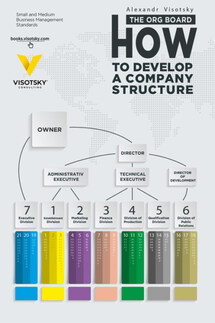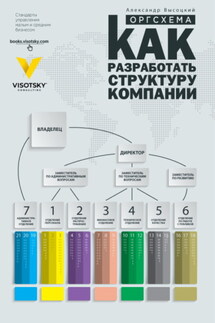The org board. How to develop a company structure - страница 7
Even in a relatively successful business, sometimes the executive does not understand the VFP of the company, and, therefore, his own VFP. Two years ago, I visited a restaurant that served Russian cuisine about 6 miles outside a small Russian town. The restaurant was unique because they grew their own delicious vegetables and herbs, and the interior of the restaurant consisted of separate rooms that emulated the rooms of an ordinary residential house from the Soviet period. No two rooms looked the same and each guest was greeted by the waiter who acted as the owner of the house. Having dinner there was more like visiting the house of your hospitable friends rather than a restaurant. Even though I’d eaten in many Russian restaurants, I'd never tasted such delicious Russian cuisine. That restaurant became extremely popular and well known in the city, and generated a decent income for its owner. After several years of business success, the owner decided to expand the business and opened a restaurant in a resort town by the sea. She invested all her savings in this new restaurant that was completely different from the original. It had neither its own vegetable garden nor the unique rooms. She transferred the chef and the best waiters to the new restaurant, and within a year she experienced nothing but losses. Moreover, the lack of attention to running the first restaurant, loss of qualified staff, and cutting operating expenses resulted in a significant decline of the business.
I don't know what her motivation was – maybe her dream was to retire by the sea. But from a business perspective, it wasn’t a smart decision. The reason for her failure is simple – she had never considered what the VFP of her old successful restaurant was, and what the new VFP should have been. People came to the old restaurant for a special meal and the ambiance. Visiting this restaurant was an event in itself, and customers willingly traveled several miles for the experience. The new restaurant was nothing like that. It only had the good recipes from the original restaurant, but without the supply of special fresh produce and the unique setting. This new restaurant, which was actually one of many located in the neighborhood, had a completely different VFP. Lack of understanding of the exact product the client is paying for resulted in her almost losing the business.
Retail companies have their own VFP, and it is not the merchandise they sell. By definition, the VFP is what a person produces, and retail companies do not produce the merchandise itself. Retailers "produce" the availability of a product to the customer. Trading and retail activities always entail providing a certain selection of goods at a particular location, plus some additional services. That is why in retail it is so important to assess the selection of goods provided in relation to the location. Duane Reade[5] stores offer their customers a limited range of everyday products conveniently located so that they could drop in during their commute. Macy’s[6] department stores offer their customers a wide selection of inexpensive clothing and household goods. You do not stop there on your way home. You go there to buy a summer dress and end up leaving tired, with stuffed shopping bags that barely fit in the back seat of your car. Both of these are in the retail business but they have very different VFPs. And what’s interesting, is that in both examples the function of selling the merchandise is practically nonexistent, as they are self-service stores. It would be erroneous to state that the VFP of these stores were “sold goods” when they don’t take effort to sell, i.e. to exchange goods for money. By selling, I mean conscious actions of a salesperson that lead to a customer making a single purchase or purchasing more items. Yet, these stores consistently and successfully create a selection of goods wanted by their customers and correctly present them so their customer can easily find the right product by himself. They ensure that the store’s location is convenient, and that the product’s price and quality meet clients’ expectations.









